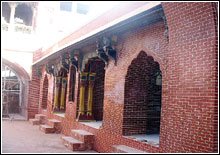Heritage Restoration
Monday, July 19, 2010
The restoration of southern and northern parts of historical Wazir Khan Mosque has finally been completed, thanks to the generous funding by the US government.
The parts known as ‘Craft bazaar’, which originally housed calligraphers and bookbinders, are also ready to serve as a showcase of traditional arts and crafts after years of neglect. These parts of the mosque were in a state of disrepair for more than three decades; and the provincial archaeology department responsible for the maintenance did not have money for its restoration.
It was a typical case of blessing in disguise as some officials of the US embassy visited the mosque, a couple of years ago, and expressed serious concern over its decay. An amount of $49,000 under the US Ambassador's Fund for Cultural Preservation was allotted for its restoration.
 According to an archaeology department official, the restoration has been carried out on the pattern it is constructed. "It has been brought to its original form," he adds. Moreover, the department maintains that it will rent out its (craft bazaar) shops to wood-workers so that they can display their artesan work.
According to an archaeology department official, the restoration has been carried out on the pattern it is constructed. "It has been brought to its original form," he adds. Moreover, the department maintains that it will rent out its (craft bazaar) shops to wood-workers so that they can display their artesan work.Located in a thickly populated area of Dehli Gate, in the walled city, it is one of the two most spacious mosques in Lahore. It reflects a blend of Persian and Indian styles of architectures.

Chiniot-born Hakeem Aleemuddin Ansari, known as Nawab Wazir Khan, had laid its foundation stone in 1634 and its construction was completed in 1635. It had been built with bricks and tiles and was entirely covered with arabesque painting and lacquered tiles. The inlaid pottery decorations and panelling of the walls were vivid and glowing.
The panels of pottery were set in hard mortar and flowers, with trees and goblets decorating the exterior of the walls.The plinth level was a storey higher than the ground. The facade of the main entrance of this imposing structure from the eastern side is laid with glazed tiles, which have numerous inscriptions of the Kalima going up to the ceiling in Kashikari.
Two wells had been dug to draw fresh water to fill the pond at the centre of the courtyard. Only one of them is functioning now.

One of the striking features of the mosque is its minarets built on the four corners of the courtyard. The flour of the mosque is paved creatively with symmetrical designs made of bricks.
Text and photographs by Zulquernain Tahir
Text and photographs by Zulquernain Tahir
Labels: Heritage
posted by S A J Shirazi @ 8:23 AM,
![]()
![]()
0 Comments:



Post a Comment